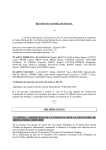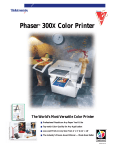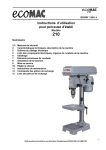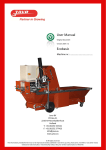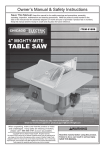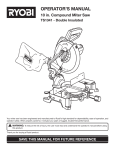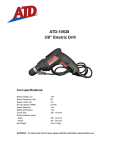Download Proxxon 37070 Use and Care Manual
Transcript
FET Manual Replacement Parts List Part-No. description Part-No. description 37070 - 01 Motor 27070 - 41 Screw 27070 - 02 Motor Casing, small 27070 - 42 Saw table 27070 - 03 Motor Casing, big 27070 - 43 Screw 27070 - 04 Stop plate 27070 - 44 Cover plate 27070 - 05 Screw 27070 - 45 Screw 27070 - 06 Nut 27070 - 46 Front cover 27070 - 07 Nut 27070 - 47 Screw 27070 - 08 Fan 27070 - 48 Washer 27070 - 09 Set screw 27070 - 49 Screw 27070 - 10 Cap 27070 - 50 Indicator 27070 - 11 Screw 27070 - 51 Washer 27070 - 13 Ball bearing 27070 - 52 Hand wheel 27070 - 14 Poully 27070 - 53 Knurled nut 27070 - 15 Toothed belt 27070 - 54 Screw 27070 - 16 Poully 27070 - 55 Riving knife 27070 - 17 Spacer disc 27070 - 56 Pin 27070 - 18 Screw 27070 - 57 Shaft locking clip 27070 - 19 Connecting rod 27070 - 58 Saw blade cover, left half 27070 - 20 Distance bushing 27070 - 59 Saw blade cover, right half 27070 - 21 Angle adjusting plate 27070 - 60 Screw 27070 - 22 Axis 27070 - 61 Screw 27070 - 23 Extension spring 27070 - 62 Plate 27070 - 24 Lower casing 27070 - 63 Screw 27070 - 25 Lustre terminal 27070 - 64 Upper casing part 27070 - 26 Connecting cable 27070 - 65 Holder 27070 - 27 Connecting cable 27070 - 66 Screw 27070 - 28 Holder 27070 - 67 Knurled nut 27070 - 29 Switch 27070 - 68 Washer 27070 - 30 Screw 27070 - 69 Holder for upper casing part 27070 - 31 Screw 27070 - 70 Hinge 27070 - 32 On-Off switch 27070 - 71 Screw 27070 - 33 Cover 27070 - 72 Nut 27070 - 34 Screw 27070 - 73 Screw 27070 - 35 Allen key set 27070 - 74 Screw 27070 - 37 Saw blade 27070 - 75 Blocking lever 27070 - 38 Washer 27070 - 76 Bushing 27070 - 39 Screw 27070 - 77 Screw 27070 - 40 Cover plate 27070 - 78 Extenable saw bearing 2 Replacement Parts List Part-No. description Part-No. description 27070 - 79 Guiding rod 27070 - 117 Screw 27070 - 80 Set screw 27070 - 118 Connecting piece 27070 - 81 Supporting stop 27070 - 119 Screw 27070 - 82 Resting ball 27070 - 120 Rubber hose 27070 - 83 Compression spring 27070 - 121 Label „angle scale“ 27070 - 84 Set screw 27070 - 122 label „ fine adjustment“ 27070 - 85 Pin 27070 - 123 Label „scale“ 27070 - 86 Supporting lever 27070 - 139 Board 27070 - 87 Metal core 27070 - 125 Connecting cable 27070 - 88 Lock washer 27070 - 126 Label „Exhaustion“ 37070 - 89 Cable connection 27070 - 127 Label „Transport lock“ 27070 - 90 Tension relief 27070 - 128 Label „Proxxon“ 27070 - 91 Downer strain relief clamp 27070 - 129 Label 27070 - 92 Upper strain relief clamp 27070 - 130 Grommet 27070 - 93 Cover 37070 - 131 Rating plate 27070 - 94 Screw 27070 - 132 Cable grommet 27070 - 95 Ruler 27070 - 133 Cable grommet 27070 - 96 Fine adjusting screw 27070 - 134 Work piece pusher 27070 - 97 Nut 27070 - 135 Screw 27070 - 98 Clamping piece 27070 - 136 Stop 27070 - 99 Guiding rod 27070 - 137 manual (not shown) 27070 - 100 Guidin piece 27070 - 138 Shaft 27070 - 101 Longitudinal stop 27070 - 102 Screw 27070 - 139 27070 - 140 Board Plate 27070 - 103 Plate 27070 - 104 Knurled nut 27070 - 105 Clamping piece 27070 - 106 Clamping lever 27070 - 107 Stop bar 27070 - 108 Guidance 27070 - 109 Pointer 27070 - 110 Screw 27070 - 111 Set screw 27070 - 112 Mitre gauge 27070 - 113 Washer 27070 - 114 Knurled screw 27070 - 115 Knurled screw 27070 - 116 Centering device 3 21 22 1 2 3 20 8 9 10 4 11 12 5 13 14 15 6 19 4 5 7 3 16 17 7 18 19 10 4 11 6 12 5 13 14 15 6 16 17 18 7 19 20 8 21 22 18 9 23 24 7 17 16 8 9 10 Fig. 2 7 3 8 9 10 90 4 80 11 12 60 5 13 11 40 14 15 16 7 0 17 90 20 6 20 18 40 60 19 10 4 11 12 5 13 14 15 6 16 17 7 18 19 20 8 15 21 22 9 23 24 12 14 13 Fig. 1 Fig. 3 250 190 Fig. 5 Fig. 4 Fig. 5a 4 Fig. 6 Fig. 7 Fig. 8a Fig. 9 Fig. 8b Fig. 9a Fig. 10a Fig. 10b Fig. 10c 5 Fig. 11 Fig. 10d 1 3 90 80 1 60 2 40 0 90 20 20 11 5 12 5 13 14 15 6 16 13 14 15 6 2 16 17 7 17 7 18 19 20 21 8 18 19 20 8 21 22 9 22 9 23 60 40 3 10 4 23 24 24 Fig. 13a Fig. 12 3 6 55 4 4 7 90 1 80 60 40 1 0 90 20 20 40 10 4 11 12 5 13 14 15 6 16 17 7 18 19 20 8 21 60 2 22 9 23 24 Fig. 13c Fig. 13b Fig. 14 Fig. 13d 6 Contents: In general WARNING! For Your Own Safety Read Instruction Manual Before Operating Saw! Dear Customer! ALWAYS WEAR EYE PROTECTION The use of these instructions • makes it easier to become acquainted with the device, • prevents malfunctions due to improper handling, and • increases the service life of your device. Always keep these instructions close to hand. Only operate this device with exact knowledge of it and comply with the instructions. PROXXON will not be liable for the safe function of the device for: • handling that does not comply with the usual intended use, • other application uses that are not stated in the instructions, • disregard of the safety regulations. You will not have any warranty claims for: • operating errors, • lack of maintenance. For your safety, please comply with the safety regulations at all costs. Only use original PROXXON spare parts. All rights reserved for further developments within the meaning of technical progress. We wish you much success with the device. General safety instructions Read and become familiar with this entire instructions manual. Learn the tool`s applications, limitations and possible hazards. Projectiles thrown away from the machine could cause serious permanent eye damage. Always wear safety goggles, not glasses, complying with ANSI Z87.1 (or in Canada CSA Z94-3-M88). Everyday eyeglasses have only impact resistant lenses. They are not safety glasses! Safety goggles are available at many local retail stores. Glasses or goggles not in compliance with ANSI or CSA could seriously hurt you when they break. Important safety regulations 1. KEEP GUARDS IN PLACE and in working order. 2. REMOVE ADJUSTING KEYS AND WRENCHES. Form habit of checking to see that keys and adjusting wrenches are removed from tool before turning it on. 3. KEEP WORK AREA CLEAN. Cluttered areas and benches invite accidents. 4. DON’T USE IN DANGEROUS ENVIRONMENT. Don’t use power tools in damp or wet locations, or expose them to rain. Keep work area well lighted. 5. KEEP CHILDREN AWAY. All visitors should be kept safe distance from work area. 6. MAKE WORKSHOP KID PROOF with padlocks, master switches, or by removing starter keys. 7. DON’T FORCE TOOL. It will do the job better and safer at the rate for which it was designed. 8. USE RIGHT TOOL. Don’t force tool or attachment to do a job for which it was not designed. 9. USE PROPER EXTENSION CORD. Make sure your extension cord is in good condition. When using an extension cord, be sure to use one heavy enough to carry the current your product will draw. An undersized cord will cause a drop in line voltage resulting in loss of power and overheating. Table xx? shows the correct size to use depending on cord length and nameplate ampere rating. If in doubt, use the next heavier gage. The 7 10. 11. 12. 13. 14. 15. 16. 17. 18. 19. 8 smaller the gage number, the heavier the cord. Exception No. 1: The reference to the table and the table itself may be omitted if a statement indicating the appropriate gage and length is incorporated into the instruction. Exception No. 2: The information regarding extension cords need not be provided for a permanently connected tool. WEAR PROPER APPAREL. Do not wear loose clothing, gloves, neckties, rings, bracelets, or other jewelry which may get caught in moving parts. Non-slip footwear is recommended. Wear protective hair covering to contain long hair. Exception: The reference to gloves may be omitted from the instructions for a grinder. ALWAYS USE SAFETY GLASSES. Also use face or dust mask if cutting operation is dusty. Everyday eyeglasses only have impact resistant lenses, they are NOT safety glasses. SECURE WORK. Use clamps or a vise to hold work when practical. It’s safer than using your hand and it frees both hands to operate tool. DON’T OVERREACH. Keep proper footing and balance at all times. MAINTAIN TOOLS WITH CARE. Keep tools sharp and clean for best and safest performance. Follow instructions for lubricating and changing accessories. DISCONNECT TOOLS before servicing; when changing accessories, such as blades, bits, cutters, and the like. REDUCE THE RISK OF UNINTENTIONAL STARTING. Make sure switch is in off position before plugging in. USE RECOMMENDED ACCESSORIES. Consult the owner’s manual for recommended accessories. The use of improper accessories may cause risk of injury to persons. NEVER STAND ON TOOL. Serious injury could occur if the tool is tipped or if the cutting tool is unintentionally contacted. CHECK DAMAGED PARTS. Before further use of the tool, a guard or other part that is damaged should be carefully checked to determine that it will operate properly and perform its intended function — check for alignment of moving parts, binding of moving parts, breakage of parts, mounting, and any other conditions that may affect its operation. A guard or other part that is damaged should be properly repaired or replaced. 20. DIRECTION OF FEED. Feed work into a blade or cutter against the direction of rotation of the blade or cutter only. 21. NEVER LEAVE TOOL RUNNING UNATTENDED. TURN POWER OFF. Don’t leave tool until it comes to a complete stop. Additional safety instructions for table saws: ALWAYS USE BLADE GUARD, RIVING KNIFE, AND ANTI-KICKBACK PAWLS on all „through-sawing“ operations. Through-sawing operations are those in which the blade cuts completely through the workpiece as in ripping or crosscutting. Keep the blade guard down, the anti-kickback pawls down, and the riving knife in place over the blade. ALWAYS SECURE WORK firmly against rip fence or miter fence. ALWAYS USE A PUSH STICK FOR RIPPING NARROW STOCK. A push stick is a device used to push a workpiece through the blade instead of using your hands. Size and shape can vary but the push stick must always be narrower than the workpiece to prevent the push stick from contacting the saw blade. When ripping narrow stock, always use a push stick, so your hand does not come close to the saw blade. Use a featherboard and push blocks for non-through cuts. NEVER perform any operation „freehand“ which means using only your hands to support or guide the workpiece. Always use either the rip fence or miter fence to position and guide the work. NEVER stand or have any part of your body in line with the path of the saw blade. NEVER reach behind, over, or within three inches of the blade or cutter with either hand for any reason. MOVE THE RIP FENCE out of the way when crosscutting. NEVER use rip fence as cutoff gage when crosscutting. NEVER attempt to free a stalled saw blade without first turning the saw OFF and disconnecting the saw from the power source. PROVIDE ADEQUATE SUPPORT to the rear and sides of the saw table for wide or long work pieces. Use a sturdy „outrigger“ support if a table extension more than 24 inches long is attached to the saw. AVOID KICKBACKS (work thrown back toward you) by: A. Keeping blade sharp. B. Keeping rip fence parallel to the saw blade. C. Keeping riving knife, anti-kickback pawls, and blade guard in place and operating. D. Not releasing the work before it is pushed all the way past the saw blade using a push stick. E. Not ripping work that is twisted or warped or does not have a straight edge to guide along the fence. AVOID AWKWARD OPERATIONS AND HAND POSITIONS where a sudden slip could cause your hand to move into the cutting tool. CHECK WITH A QUALIFIED ELECTRICIAN or service personnel if the grounding instructions are not completely understood or if in doubt as to whether the tool is properly grounded. USE ONLY CORRECT ELECTRICAL DEVICES: 3wire extension cords that have 3-prong grounding plugs and 3-pole receptacles that accept the tool’s plug. DO NOT MODIFY the plug provided. If it will not fit the outlet, have the proper outlet installed by a qualified electrician. USE ONLY RECOMMENDED ACCESSORIES listed in this manual or addendums. Blades must be rated for at least 6,0000 rpm. Use of accessories that are not listed may cause the risk of personal injury. Instructions for safe use of accessories are included with the accessory. DOUBLE CHECK ALL SETUPS. Make sure blade is tight and not making contact with saw or workpiece before connecting to power supply. MAKE SURE THE WORK AREA HAS AMPLE LIGHTING to see the work and that no obstructions will interfere with safe operation BEFORE performing any work using the table saw. ALWAYS TURN OFF SAW before disconnecting it, to avoid accidental starting when reconnecting to power supply. SAVE THESE INSTRUCTIONS. Refer to them frequently and use to instruct other users. If you loan someone this tool, loan them these instructions also. Further safety instructions This machine is for indoor use only. Do not expose to rain or use in damp locations. Use only accessories recommended for this table saw. Follow the instructions that accompany accessories. Use of improper accessories may cause hazards. Do not attempt to modify this tool or create accessories not recommended for use with this tool. Any such alternation or modification is misuse and could result in hazardous condition leading to possible serious injury. To avoid injury from unexpected starting or electrical shock, do not plug the power cord into a power source receptacle during unpacking and assembly. This cord must remain unplugged whenever you are working on the table saw. If any part is missing or damaged, do not plug the table saw in until the missing or damaged part is replaced, and assembly is complete. To avoid electrical shock, use only identical replacement parts when servicing grounded tools. For your safety, never connect the plug to the power source receptacle until the assembly and adjustment steps are completed, and you have read and understood the safety and operating instructions. To avoid injury from accidental start, make sure the switch is in the OFF position and the plug is not con- 9 nected to the power source receptacle before changing any parts or tools (i. e. saw blade) For your own safety, use only saw blades sized and recommended for this table saw. Follow the instructions that accompany the millers. ment, such as those dust masks that are specially designed to filter out microscopic particles. Use a vacuum cleaner for wood dust collection as described in our manual whenever possible. Grounding instructions: To avoid fire or toxic reaction, never use gasoline, naphtha, acetone, lacquer thinner, or similar highly volatile solvents to clean the table saw. Do not allow brake fluids, gasoline, or penetrating oils to come in contact with the plastic parts. They contain chemicals that can damage or destroy plastics. When servicing use only PROXXON replacement parts. Use of any other parts may create a hazard or cause product damage. Any attempt to repair or replace electrical parts on this lathe may create a hazard unless repair is done by a qualified service technician. Repair service is available at your PROXXON service center (You find the address at the back of this manual) Never work with a device that has faulty or defective parts. Your table saw might no longer be safe. Therefore, have any damage immediately repaired by the Proxxon Customer Service! WARNING: Some dust created by power sanding, sawing, grinding, drilling, and other construction activities contains chemicals known to the State of California to cause cancer, birth defects or other reproductive harm. Some examples of these chemicals are: • lead from lead-based paints, • crystalline silica from bricks and cement and other masonry products, and • arsenic and chromium from chemically-treated lumber. Your risk from these exposures varies, depending on how often you do this type of work. To reduce your exposure to these chemicals: work in a well ventilated area, and work with approved safety equip- 10 1. All grounded, cord-connected tools: In the event of a malfunction or breakdown, grounding provides a path of least resistance for electric current to reduce the risk of electric shock. This tool is equipped with an electric cord having an equipment-grounding conductor and a grounding plug. The plug must be plugged into a matching outlet that is properly installed and grounded in accordance with all local codes and ordinances. Do not modify the plug provided — if it will not fit the outlet, have the proper outlet installed by a qualified electrician. Improper connection of the equipment-grounding conductor can result in a risk of electric shock. The conductor with insulation having an outer surface that is green with or without yellow stripes is the equipment-grounding conductor. If repair or replacement of the electric cord or plug is necessary, do not connect the equipment-grounding conductor to a live terminal. Check with a qualified electrician or service personnel if the grounding instructions are not completely understood, or if in doubt as to whether the tool is properly grounded. Use only 3-wire extension cords that have 3prong grounding plugs and 3pole receptacles that accept the tool’s plug. Repair or replace damaged or worn cord immediately. 2. Grounded, cord-connected tools intended for use on a supply circuit having a nominal rating less than 150 volts: This tool is intended for use on a circuit that has an outlet that looks like the one illustrated in Sketch A in Figure 72.1. The tool has a grounding plug that looks like the plug illustrated in Sketch A in Figure 72.1. A temporary adapter, which looks like the adapter illustrated in Sketches B and C, may be used to connect this plug to a 2-pole receptacle as shown in Sketch B if a properly grounded outlet is not available. The temporary adapter should be used only until a prop- erly grounded outlet can be installed by a qualified electrician. The green-colored rigid ear, lug, and the like, extending from the adapter must be connected to a permanent ground such as a properly grounded outlet box. Minimum gage for cord Ampere Rating Volts 120 V 240 V Total length of cord in feet 25 ft. 50 ft. 50 ft. 100 ft. 100 ft. 200 ft. 150 ft. 300 ft. More Than Not More Than 0 6 18 16 16 14 6 10 18 16 14 12 10 12 16 16 14 12 12 16 14 12 Description of machine The FET table saw is a well thought-out machine for all occurring sawing tasks in the range of small and fine applications. A powerful motor, solid mechanics, high-quality materials and meticulous production make this a reliable tool for all possible sawing applications. Depending on the utilised saw blades, all types of wood, many non-ferrous metals, ceramics and plas- AWG Not Recommended tics as well as many other materials can be processed with the machine. The corresponding saw blades can be obtained from Proxxon and will be mentioned in more detail later on. The bench is made of stable aluminium die casting and forms one unit together with the motor suspension: The guarantees the highest strength and naturally also affects the precision of the working results. 11 To guarantee the highest possible flexibility, we offer different types of limit stops that are included with the machine. So there is something for every application: There is a longitudinal stop that runs in a guide along the front of the bench that can be easily shifted and arrested by hand, or which can be used with the precisely adjustable graduated scale. Adjusting capabilities in the tenth of a millimetre range leave nothing to be desired and make it easy to saw work pieces to the desired, previously adjusted measure. In addition there is a sophisticated and precise angle stop which can be extended with an aluminium profile strip with a moving clamping piece for the exact reproduction of many parts to be sawed out with equal angles and each with the same dimensions. The safety aspect was taken care of as well: The saw blade is covered by a sturdy saw blade guard which automatically moves up when contact is made with the work piece, and which only releases as much of the saw blade as necessary. Caution! For your own safety, it is understood that the saw may never be operated without this protective guard! Legend (fig. 1) 1. Saw blade guard 2. Saw table 3. Saw blade 4. Connection for dust suction 5. Longitudinal stop 6. Key parking slot 7. Rubber connecting piece for suction 8. Allen key 9. Allen key 10. Push-rod 11. Angle stop 12. Knurled screw for fine adjusting 13. Motor unit 14. Angle scale for saw blade tilt 15. Saw blade adjustment for depth of cut 16. Clamping piece 17. Limit stop strip 18. Mains cable 19. On - Off switch 20. Scale for longitudinal stop 21. Extendable saw support 22. Auxiliary stop Technical data The upper part of the device is hinged so that it can be opened for cleaning and maintenance purposes. Thus the interior of the device can be cleaned of chips and dust with a vacuum cleaner, for example. To exclude any kind of hazard, a switching contact disconnects the electrics from the power mains when the upper housing part is open. But during all cleaning, maintenance and adjusting work (and of course during sawing) please remember that your FET is not a play toy but a tool for woodworking and is thus a potential source of danger! Among others a push-rod for the secure feed of more compact work pieces and two Allen keys are also included in the delivery. These can be stored in a „key parking slot“ on the right side of the housing. In the interests of your own safety, please carefully read through and comply with the attached safety notes, which are also mentioned in these instructions, and make sure that you have also understood them! 12 Rotational speed: 6000 rpm Saw blade diameter max. 3 11/32” (85 mm) Depth of cut max.: (in wood, with blade Ø 3 5/32”, 80 mm) ca. 1” (25 mm) Saw blade drill hole: 13/32“ (10 mm) Motor: Voltage: Power consumption: 110-120 Volt, 50/60 Hz 1,6 A STS 10 min Setting up the saw Caution! Make sure the mains plug is disconnected! Unpacking Caution! Please note that transport blocks have been attached to the device during packing to avoid damage during transportation. Make sure you remove all of them before commissioning! Carefully read through the instructions and especially observe the following chapter! A transport block made of cardboard is inserted on the inside of the saw. This must be removed before initial commissioning. How to swing up the upper housing part is explained in the following chapter. Swinging open the upper housing part 1. Please open the packaging box to unpack, carefully remove the saw and deposit it on a firm and level surface. 2. Release the knurled screw 1 (fig. 2) and swing up the upper housing part 2. 3. Permit the latch 3 to engage. 4. Before first commissioning, remove the cardboard that was used as safeguard during the transport. 5. Release the latch 3 of the support and push the upper housing part back down. Caution! Hold on to the upper part when pushing down! Injuries might be caused if the upper part drops down unchecked. 6. Retighten knurled screw 1. 1. Swing up the upper part of the saw 2. Permit the latch to engage 3. Now you can see four hexagonal indentations on the inside above the four screw holes in the housing bottom, see fig. 3. These are intended to receive M6 hexagon nuts, or the heads of M6 (or similar) hexagon screws. Insert sufficiently long screws 2 from inside through the opening in the housing bottom and bolt them through the drill holes that you previously drilled in the underlay 3. 1. Use a drilling template for the required hole spacing. You will find a sketch with the dimensions at fig. 4. 4. Then release the latch of the support and push the upper housing part back down. 5. Do not forget to tighten the knurled screw 1 (fig. 2)! Saw blade guard Your FET is equipped with a saw blade guard. It is designed in such a way that moves up as far as necessary during sawing and then drops back into its home position. It also adapts to the various adjusted cutting depths. Caution! The saw blade guard is an important safety tool and may in no way be tampered with or even dismantled. Operating the saw without this guard is dangerous! While setting up and transporting the saw, always may sure that the upper saw blade cover is in its correct position. The free-lying, sharp teeth of the saw blade pose a considerable risk of injury! Fastening the saw Generally the saw must be set up on a fixed and level surface, ideally on a heavy workbench or a solid table. To obtain a secure hold, your FET should be screwed to the surface: For this purpose there are four holes in the housing bottom so that fastening screws can be screwed into them. Note: Safe and precise work is only possible with careful fastening! Therefore, please proceed as follows: Secure the saw blade guard with the splitting wedge (Fig. 5 and 5a) Caution! For packaging reasons, the saw blade guard and the splitting wedge are not attached when the device is delivered. However, assembly is rather simple: Caution! Make sure the mains plug is disconnected! 13 1. Swing open the upper housing part and arrest. 2. Please note that the saw blade in its delivered condition is in the lower position to guarantee accessibility to the drive unit. Otherwise, please proceed as explained in the section "Height adjustment of the saw blade". 3. If the two screws 1 (fig. 5a) are not loose, please release them slightly with a screwdriver. Insert the orange-coloured saw blade guard with the splitting wedge 2 in the saw blade slot 3 and insert behind the little plate clip 4 like shown in Fig. 5). Please ensure correct fit: The splitting wedge is seated on the upper of the two screws 1 with its longer cutout (fig. 5a) up to the limit stop! Make sure the splitting wedge is fitted correctly in any case! Only tighten both screws 1 afterwards! After you have tightened the screws, please check once more if the splitting wedge is seated firmly and if the saw blade can be turned freely. 4. Push the upper housing part back down and secure with the knurled screw. 5. Set the desired saw blade position as described further down in the chapter "Height adjustment of the saw blade". Settings Height adjustment of the saw blade To adapt the depth of cut, the position of the saw blade can be regulated in the height. On the one hand, this optimises the sawing performance, and on the other hand the risk of injury is reduced due to the restriction of the free saw blade part. Caution! Make sure the mains plug is disconnected for all adjusting work! 1. Release the larger knurled button 1 (fig. 6) at the front operating plate and unscrew by a few revolutions 2. The saw blade position can now be set using the smaller knurled button 2: Turning clockwise will adjust the blade upwards, and turning counterclockwise will adjust the blade downwards. 3. After the desired position is achieved, retighten the knurled button 1. 14 Adjusting the saw blade tilt The saw blade can be tilted to manufacture mitre cuts. The desired value is set, or read, with the help of the angle scale. Caution! Make sure the mains plug is disconnected for all adjusting work! 1. Release handwheel 1 (fig. 7). 2. Swing the saw blade to the right with the handwheel. 3. Set or read off the desired angle with indicator 2 at the angle scale 3. 4. Arrest the saw blade position by turning the handwheel 1 shut Extendable saw table Caution! Make sure the mains plug is disconnected for all adjusting work! In order to place larger work pieces easily and securely on the saw table, it has been designed as an extendable saw table. The extension is quite simple: Please note: 1. Use your finger to push the curry-coloured limit stop edge 1 (fig. 8a) towards the back. This makes it move out upwards. 2. Pull out the saw table 2 with the limit stop edge into the desired position, see fig. 8b. If necessary, support with the swivelling lever 3. 3. The small knurled screw 4 can be used to clamp the extendable saw table into the desired position, as necessary. 4. Now push the limit stop edge 1 back into its initial position to achieve a plane surface. It is now possible to work with the saw. Please note: The limit stop edge can also be used for larger work pieces as a longitudinal stop, of course. 5. After completing your work, simply push the extendable saw table 2 back into the initial position. If necessary, fold up the swivelling lever 3 before. Dust suction At the back of the housing of your FET you will find a connecting piece for dust suction, see fig. 9: a vacuum cleaner is connected here. This should always be operational while working! Not only because it guarantees a clean working environment, but also because this prevents the interior of the saw from becoming contaminated from sawdust. The vacuum cleaner hose is simply connected to the rubber adapter, as shown in the picture 9a. Another small tip: When using the Proxxon CW-matic vacuum cleaner, manual switching on and off is no longer necessary. The CW-matic is equipped with an automatic control that switches on and off automatically whenever the electrical tool is activated or deactivated. that both fixing options locking handle 3 and knurled screw 4 are released! The scale 5 was attached with restricted rotation. Please make sure it is properly seated when you insert the limit stop. Rough adjustment of the longitudinal stop The rough adjustment simply by shifting the longitudinal stop without using the scale 5 (fig. 10b) is sufficient for many cases. When you shift the longitudinal stop, please make sure that both fixing options locking handle 3 and knurled screw 4 are released! Once the desired position is achieved, the longitudinal stop is arrested by tightening the knurled screw 4 and then clamped with the locking handle 3. Working with the limit stops Working with the longitudinal stop Longitudinal stops are indispensable working aids for producing any number of work pieces with exactly the same width (or length) without having to mark the piece to be sawn each time. The material to be sawn is simply guided along the longitudinal stop with slight pressure during the sawing procedure. The measure of the finished sawn work piece thus corresponds to the distance of saw blade and limit stop edge. If necessary, you can refer to the scale at the front of the housing to adjust the longitudinal stop. The future measure of the work piece can be read off from a marking. However, the scale must be adjusted exactly to the saw blade beforehand – therefore „zeroised“. How this is done is described below. The scale is dimensioned for the use of the limit stop on both sides of the saw blade. The most various sawing tasks are therefore no problem. Inserting, or removing, the longitudinal stop The longitudinal stop 1 (fig. 10a) is inserted, or removed, from the side (from the right or left) in the guide 2 at the saw table. While you are shifting, inserting, or removing the longitudinal stop make sure Adjusting the longitudinal stop with the help of the scale 1. When you shift the limit stop, please make sure that the locking handle 3 and knurled screw 4 are released. 2. The longitudinal stop can now be shifted in its guide using the help of the scale 5. The position can be read from the left front limit stop edge 6, see fig. 10 c. Caution: The read value will only agree if the „zero position“ of scale 5 is correct! How to correctly adjust the zero position of the scale is described in the section „Adjusting the limit stop scale“. 3. Arrest the longitudinal stop by tightening knurled screw 4 and then clamping the locking handle 3. Adjusting the limit stop scale (zero position) For the reliable use of the scale 5 for the longitudinal stop, its position must first be co-ordinated to the saw blade – therefore „zeroised“. This process is absolutely necessary after the saw blade has been replaced with a saw blade of different thickness, or if the limit stop was finely adjusted (see section „Fine 15 adjustment of the longitudinal stop“) at the knurled screw 6 (fig. 10d). ened. After adjustment is completed, the limit stop must be tightened with locking handle 3 to continue sawing! Caution! Make sure the mains plug is disconnected for all adjusting work! 1. Make sure that locking handle 3 and knurled screw 4 are released. 2. Move the longitudinal stop 1 with the left edge 6 over the „0“ marking of the scale (either left or right from the saw blade, depending on what is needed for the task) as shown in fig. 10d and fix the position by tightening knurled screw 4. 3. By turning the fine adjustment knob 7 bring the scale with its arrested longitudinal stop into the position where the side of the longitudinal stop facing the saw blade just barely touches the saw blade. Please carefully lift the saw blade guard 8 to do so, if necessary! Auxiliary stop Appropriate use of the auxiliary stop is made to be able to easily cut somewhat larger work pieces as well. For this, the saw table must be extended first, as described in the chapter „Extendable saw table“; but the limit stop edge is not „sunk“ in the extendable part by „pressing in“ but simply stays outside. The distance to the saw blade determines the sawing width, which can therefore be varied depending on by how much the saw table is pushed in, or extended. To saw, always fix the limit stop by tightening the knurled screw. See fig. 8a. Angle stop Now the distance between the saw blade and limit stop is „0“ as shown by the scale. The limit stop can now be aligned with the help of the scale, as described in the section „Adjusting the longitudinal stop with the help of the scale“: The value read from the scale now corresponds exactly to the distance longitudinal stop – saw blade and thus the desired width of the work piece. Caution! It is possible that before adjustment in the zero position, the scale is in a position where the longitudinal stop already touches the saw blade before the left limit stop edge has reached the „0“ position on the scale. In this case simply correct the scale position with the fine adjustment knob 7. Fine adjustment of the longitudinal stop If after the sawing process it is necessary to make minor changes to the position of the limit stop (despite previous careful adjustment) to achieve the desired width, it is possible to move the limit stop for a small amount in the desired direction with the fine adjustment knob 7, see fig. 10d. Please note: One complete revolution will move the limit stop by 1 mm! Caution! For this procedure, the lock handle 3 must be released, but the knurled screw 4 must be tight- 16 If it is necessary to cut a board at right angles, or a strip with mitre cut, then this can be sawn by using the angle stop. This runs in the guides provided either on the right or on the left of the saw blade, as required. 1. Insert the angle stop in the guide 1 to the right or left of the saw blade, see fig. 11. 2. Release knurled screw 2, set the desired angle at the scale 3 and retighten the knurled screw. Working with the limit stop strip with clamping piece for angle stop Ideal, e.g. if many strips will be cut with mitre and equal length, see fig. 12. The limit stop strip is connected to the angle stop 2 to do this. The clamping piece 3 is used as length stop. Assembly and adjustment Push the limit stop strip 1 into the guide of the angle stop 2 (see fig. 13a) and insert together in the guide in the saw table. Caution! The knurled screw must be in the „released“ position otherwise the limit stop cannot be inserted. 1. To adjust the angle, release knurled screw 4 and set the desired value at the scale 5. Retighten knurled screw 4. Adjust position of limit stop strip 1 and clamp firmly by tightening the knurled screw 6. Always keep the push-rod close to hand while working! 2. Caution! Make sure at all costs that the limit stop strip 1 is correctly seated in the receiver of the angle stop 2 and that there is sufficient distance from the end of the limit stop strip to saw blade 7! In all cases: Switch off the saw and disconnect the mains plug and test to see that the limit stop strip does by no means touch the saw blade or the saw blade guard, see fig. 13c! Please note: 3. Insert clamping piece 8 in the guide of the limit stop strip (fig. 13d) and determine the position in dependence on the desired work piece length. Please note: The hexagon nut travels in the guide of the limit stop! Fix the clamping piece with the knurled screw 9.While sawing, the piece to be sawn is pushed up to the limit stop and can be crosscut as shown in fig. 12. Sawing Caution! Your FET may not be used for slitting (notch completed in the work piece)! To groove or notch, please by all means use the Proxxon groove-milling device (article number 28736). Hold the work piece on the saw table as shown in fig. 14. Adapt the feed according to the material, the saw blade and the work piece thickness! Hard materials, fine saw blades and thick work pieces do not “tolerate” as much feed as soft materials, rough saw blades and thin materials. Always operate the saw from the position as shown in Fig. 14a so that you are always in optimal control of the work piece. Stand in front of the saw while sawing! Never saw with your FET from the side or even from the back. Ensure sufficient stability while you work! If you process correspondingly small work pieces then use the included push-rod, as shown in fig. 15. This prevents your hands from coming to close to the revolving saw blade and thus reduces the risk of injury: If the device is not in use, please use the supplied push-rod in the designated housing fixture (fig. 14b)! • Only use perfect saw blades. • Always remove the mains plug for maintenance and upkeep work. • Do not let the device operate unsupervised. When sawing, press the work piece onto the work plate, guide with sensitivity and with little force, more pressure on the work plate, less pressure against the saw blade. Guide the work piece slowly into the saw blade, particularly if the blade is very thin and the teeth very fine or if the work piece is very thick. General tips on sawing For good results, please note the following points: • When sawing, press the work piece onto the work plate, guide with sensitivity and with little force; more pressure on the work plate, less pressure against the saw blade. • Make sure that the work piece is lying properly on the saw table (no burrs or sawdust) • Adapt the feed to the requirements by saw blade, speed and work piece material. • Guide the work piece slowly into the saw blade, particularly if the blade is very thin and the teeth very fine or if the work piece is very thick. • Only use perfect saw blades. • Do not let the device operate unsupervised. • Carefully mark out the check line. • Make sure there is good lighting. • Always work with connected dust suction! • If necessary, use the included push-rod to feed the work piece. Changing the saw blade Your saw is equipped with a carbide-tipped saw blade with 24 teeth and an 80 mm diameter ex works. 17 This is very well suited for most „sawing jobs“, guarantees clean cuts in the most various materials and guarantees long service life. But it will not last for ever, of course: Wear will occur depending on the intensity of use: The saw blade will become dull, more force to push the work piece is required and the quality of the cut is reduced, the mechanics of the machine are stressed more strongly than necessary. Then it is high time to replace the saw blade with a new one. It can also be necessary to use a different saw blade type for a particular task (see also the chapter „Choosing the right saw blade“ below) so that it needs to be exchanged for the standard blade. The work steps remain the same, naturally. 1. Disconnect the mains plug! 2. Turn the saw blade down as described in the chapter „Height adjustment of the saw blade“. 3. Swing open the housing as described in section „Swinging open the upper housing part“. 4. To release the screw 1 (fig 16a), the shaft on which the saw blade 2 is mounted must be blocked. To do so, insert the smaller of the two included Allen keys 3 through the small drill hole 4 in the saw table and from there insert it into the saw blade shaft through a cross-hole, see fig. 16b. If necessary, this drill hole must be „found“ somewhat by turning the saw blade by hand. A hint: For this procedure we recommend you adjust the saw blade to a relatively high height and then to lower it somewhat after finding the latching drill hole with inserted Allen key in order to gain full access to screw 1. 5. Release the hexagon-head screw 1 with the larger of the two Allen keys and remove together with disc 5. Caution! The teeth of even worn saw blades are still very sharp! Risk of injury! 6. Remove the old saw blade upwards and through the saw blade opening and place the new saw blade on the shaft. Make sure the saw blade drill hole is seated correctly at the shaft shoulder! 7. Please also make sure that the teeth are pointing in the direction as shown in the figures! 8. Screw on disc 5 with the hexagon-head screw 1 and tighten. Note that the saw shaft still needs to remain blocked with the small Allen key. 9. Release the latch, push down the upper housing part and lock with the knurled screw. Choosing the right saw blade Caution! When choosing the saw blade, make sure at all costs that the highest permissible speed is sufficiently high enough for the idling speed of the saw! Only use original Proxxon saw blades. The choice of the suitable saw blade has an enormous impact on the work result: Various characteristics such as work piece material, saw job intensity and the desired quality of the result must be considered. Proxxon has 4 different saw blades that can be used to operate the machine: Super-Cut Ø 85 x 0.5 x 10 mm, Suitable for more soft woods and plastics Article number 28 731 18 36 teeth, carbide tipped Ø 80 x 1.5 x 10 mm Use is ideal for balsa wood, plywood, softwood, fibreglass enforced sheets, hardwood, polycarbonate, plastics and aluminium Article number 28 732 24 teeth, carbide tipped Ø 80 x 1.5 x 10 mm For aluminium, hardwood, chipboard, plastic Article number 28 734 Diamond-Coated Blade Ø 85 x 0.7 x 10 mm Specifically to cut ceramic parts and fibreglass enforced sheets Article number 28 735 Maintenance and repairs: Caution! Always disconnect the mains plug before doing any cleaning, setting, maintenance or repair works! The device is maintenance-free apart from the necessity of regular cleaning (see below). Only have repairs carried out by qualified specialist personnel or, even better, by the PROXXON central service. Never repair electrical parts, but always exchange them for original spare parts from PROXXON! Cleaning the housing For a long service life, the device should be cleaned after every use with a soft cloth, hand brush or a soft brush. Even a vacuum cleaner can be recommended. Cleaning the outside of the houses can be done with a soft, possibly moist cloth. A soft detergent or other suitable cleaning agent may be used. Avoid using solvents or alcohol-based cleaning agents (e.g. benzine, rubbing alcohol, etc.) as these will affect the plastic housing shells. 19 If, despite using the dust suction during operation, it is necessary to clean the inside of the device, please simply swing up the upper housing part and vacuum the inside of the device with a vacuum cleaner. Cleaning the inside of the device Caution! Never use compressed air for blowing out! The fine wood dust could become lodged inside the motor or on electrical components and impair the reliability and the safety of the machine! 1. Make sure the mains plug is disconnected! 2. Swing open the upper housing part (see also section „Unpacking“) 3. Vacuum the inside of the device with a vacuum cleaner 4. Push down the upper housing part and lock. Replacing the toothed belt A toothed belt transmits the power from the motor to the saw blade shaft. The belt has a very long service life, but when the machine is used extensively, it could be necessary to replace it after a longer operating period. The procedure is described here. In case you are unsure, please send the saw to our Central Service. 1. Make sure the mains plug is disconnected! 2. Set the saw blade to an approx. 40° tilt as explained in section „Adjusting the saw blade tilt“. 3. Swing up the upper housing part as explained in section 6.2 4. Block the shaft with the small Allen key as described in the Chapter “Changing the saw blade”. 5. Unscrew the Phillips screw 1 (fig. 17). Remove thrust washer 2. 6. Pull off the old toothed belt 3 and fit the new toothed belt. Turn the drive at the toothed belt pullies slightly back and forth until the new toothed belt sits correctly. 7. Replace the thrust washer 2 and tighten with the Phillips screw 1. 8. Close the upper housing part and correct the saw blade tilt as desired. 20 9. Make sure to remove the Allen key for blocking the shaft before commissioning. LIMITED WARRANTY OF PROXXON POWER TOOLS FOR HOME USE Prox-Tech, Inc., (“Seller”) warrants to the original purchaser only, that all PROXXON consumer power tools will be free from defects in material or workmanship for a period of two years from the date of purchase. Seller’s sole obligation and your exclusive remedy under this limited warranty and, to the extent permitted by law, any warranty or condition implied by law, shall be the repair or replacement of parts, without charge, which are defective in material or workmanship and which have not been misused, carelessly handled, or misrepaired by persons other than Seller or Authorized Service Station. In the event of a failure of a product to conform to this written warranty, please refer to the Service and Repair section on the back of this manual and take action accordingly. This Limited Warranty does not apply to accessory items such as circular saw blades, drill bits, router bits, jigsaw blades, sanding belts, grinding wheels and other related items. Damage to the product resulting from tampering, accident, abuse, negligence, unauthorized repairs or alterations, unapproved attachments or other causes unrelated to problems with material or workmanship are not covered by this warranty. Any implied warranties shall be limited in duration to two years from date of purchase. Some states in the U.S. and some Canadian provinces do not allow limitations on how long an implied warranty lasts, so the above limitation may not apply to you. In no event shall seller be liable for any incidental or consequential damages (including but not limited to liability for loss of profits) arising from the sale or use of this product. Some states in the U.S. and some Canadian provinces do not allow the exclusion or limitation of incidental or consequential damages; so the above limitation or exclusion may not apply to you. This limited warranty gives you specific legal rights, and you may also have other rights, which vary from state to state in the U.S., province to province in Canada and from country to country. This limited warranty applies only to PROXXON power tools sold within the United States of America, Canada, the commonwealth of Puerto Rico and Mexico. For warranty coverage within other countries contact your local PROXXON Importer. 21 22 100 103 90 91 89 125 33 34 96 95 123 80 99 125 122 117 92 94 93 46 43 47 128 20 139 117 24 72 22 47 69 70 44 120 74 68 14 15 9 13 126 119 118 129 18 17 9 16 131 80 83 76 75 84 83 82 88 81 85 78 87 86 82 42 45 1 77 67 65 80 79 66 64 109 108 111 112 114 113 115 98 67 49 48 49 48 50 138 21 23 7 6 2 4 20 3 19 5 8 138 10 11 98 6 73 127 25 130 51 52 98 53 71 121 54 31 30 29 28 32 9 97 57 68 106 105 101 104 102 37 38 39 41 40 62 63 133 132 58 57 56 55 57 59 60 61 35 134 27 26 110 47 57 116 107 136 135 Schematics für FET 25 23 24 9 22 21 8 20 1 2 7 0 1 2 6 3 5 4 5 6 7 4 8 18 7 17 15 16 6 14 12 14 13 5 13 4 15 16 3 18 Fig. 14b Fig. 14a Fig. 16a Fig. 15 Fig. 16b Fig. 17 23 SERVICE AND REPAIR Your device does not work properly? Please read the operating instructions again carefully. If the unit is in fact defective, please send it to: Prox-Tech, Inc. Attn.: PROXXON Service Center 2555 Tate Blvd. S.E. PO Box 1909 Hickory, NC 28603-1909 Please make sure, that your tool is carefully packaged and include a copy of your dated proof of purchase. You will help us to react even quicker, if you describe the problem in short and please don’t forget to include your name, address and daytime telephone number. We will respond in a prompt and reliable manner. You can also order any necessary spare parts from our Service Center at the above address. Please check the article-number of the tool concerned on the nameplate of the tool and define the part needed by using the explosion drawing in the manual that came with the tool. Every part has a specific number (5 digit-XX). Please provide us with this number when ordering. For any further information call us toll free at 1-877-PROXXON (1-877-776 9966) or visit us on the web at www.proxxon.com/us. Art.-No. 37070 Ver. 01/2011 Spare Parts We reserve the right to make further alterations for the purpose of technical progress.

























